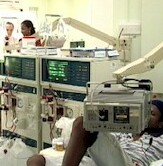
MONDAY, June 27 (HealthDay News) — In early research, blood vessels originating from a donor’s skin cells and grown in a laboratory have been successfully implanted in three dialysis patients.
These engineered grafts have functioned well for about 8 months, say researchers reporting Monday at a special online conference sponsored by the American Heart Association.
The three patients — all of whom lived in Poland and were on dialysis for end-stage kidney disease — received the new vessels to allow better access for dialysis. But the hope is that these types of bioengineered, “off-the-shelf” tissues can someday be used as replacement arteries throughout the body, including heart bypass.
“The grafts available now perform quite poorly,” said lead researcher Todd N. McAllister, co-founder and chief executive officer of Cytograft Tissue Engineering Inc., the Novato, Calif.-based maker of the grafts and the funder of the study.
Currently, these types of vessels are typically made of synthetic material or they are grafts of the patient’s own veins, McAllister explained. In either case, he said, the rate of failure and the need for redoing the procedures remains high.
In the new study, donor skin cells were used to grow the blood vessels. The vessels were made from sheets of cultured skin cells, rolled around a temporary support structure in the lab. Upon implantation the vessels typically measured about a foot long and a fifth of an inch in diameter.
After implantation, the vessels were used as “shunts” between arteries and veins in the arm to gave the patient access to life-saving dialysis.
“To date all the grafts are patent [functioning well],” McAllister said. “Perhaps most interestingly, we have seen no clinical manifestations of an immune response,” he said.
In fact, over eight months after implantation, none of the patients show any signs of rejecting the graft. The grafts have also been able to handle the high pressures and frequent needle punctures needed to deliver dialysis, the researchers found.
In earlier work, McAllister’s group showed that vessels grown using a patient’s own skin cells reduced the rate of complications typically seen with shunts by more than two-fold over 3 years.
However, the advantage of these new vessels, grown from donor cells, is that it won’t take six months to grow the tissue.
This off-the-shelf approach should make the technology available for widespread use, McAllister added. He believes that, someday, these types of blood vessels might replace the use of a patient’s own vessels for bypass surgery.
However, McAllister stressed that a phase 3 trial on the use of the grafts is only now getting underway, so it will be several years before these grafts could be clinically available.
And what about the treatment’s cost? McAllister said that producing the tissue is very expensive. Speaking with Bloomberg News, he estimated that each graft might cost between $6,000 and $10,000.
Commenting on the study, Dr. Gregg C. Fonarow, professor of cardiology at the University of California, Los Angeles, agreed that “there has been great interest in developing safer and more reliable vascular access for patients receiving dialysis.”
Access for dialysis, bleeding and infection are major causes of death for patients in dialysis, he said. “A high percentage of hospitalizations and health care expenditures in dialysis patients are due to vascular access complications,” Fonarow said.
But he cautioned that these are still early days for this technology.
“This approach appears very promising, but will need to be prospectively evaluated in much larger longer term studies to determine the full potential of tissue engineered vascular grafts for this and other uses,” he said.
More information
For more information on kidney failure, visit the U.S. National Library of Medicine.

